The Philosophy of Arthroscopic Rotator Cuff Repair
When a cowboy is too old to set a bad example, he hands out good advice.
Arthroscopic rotator cuff repair has undergone dramatic advancements in the last 20 years. As with any technological paradigm shift, this rapid progress was made possible by the marriage of insight to technology. One of the great misconceptions of our time is that technology alone will advance a discipline. The reality is that technology without understanding produces mere gadgets; technology guided by insight produces tools.
To the uninitiated, arthroscopic rotator cuff repair may seem like magic. Our goal in this book is to pull back the curtain and break the magic down into tricks, teaching the reader how to systematically perform these tricks with tools rather than gadgets.
One must always bear in mind that magic is the currency of ignorance, whereas tools are the instruments of understanding. This chapter is dedicated to understanding.
BEDROCK PRINCIPLES
The overriding premise in our philosophy of arthroscopic rotator cuff repair is that almost all cuff tears are repairable, and our surgical experience confirms that assertion. In 2003, a review of one full year of the senior author’s (SSB) surgical practice revealed that 97% of the rotator cuff tears that he operated on were fully repairable. The remaining 3% underwent varying degrees of partial repair. These results were achieved in a tertiary referral practice that included a large percentage of massive tears and revision repairs.
Despite our success at completely repairing the vast majority of cuff tears arthroscopically, we continue to hear presentations and read reports by other authors on their vast experience with salvage procedures (latissimus dorsi transfers, allograft patches, and even reverse total shoulder replacement) for “irreparable” cuff tears. We obviously have a difference of opinion on what is “irreparable,” because our stepwise approach to restoring the anatomy is successful 97% of the time.
ANATOMY AND BIOMECHANICS
Form follows function. This basic tenet of all mechanical design is particularly true of biomechanical systems. The anatomic design produces biomechanical consequences that are specific to the anatomy, and therefore it behooves us to reconstitute the anatomy (and thereby the biomechanics) as precisely as possible.
Tear Pattern Recognition
In order to properly restore the anatomy, the surgeon must accurately recognize the cuff tear pattern. Arthroscopy offers a huge advantage over open surgery in that regard. With open surgery, there has always been a bias toward medial-to-lateral mobilization of the cuff, since the open surgeon would try to bring the cuff to his window of visualization, which was an anterolateral incision. The arthroscope removes these restrictions on visualization and replaces the limited “window” of the surgical incision with an unlimited 360° field of view. This allows for a more precise determination of the tear pattern as the surgeon manipulates the cuff margins with a grasper to assess the direction of maximum cuff mobility (Fig. 2.1).
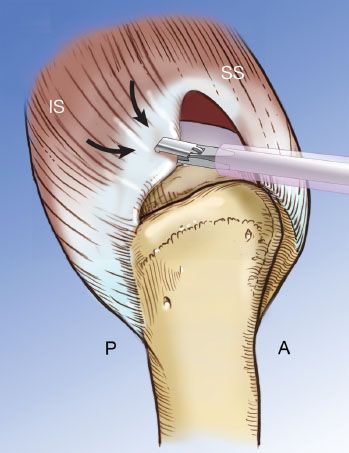
Figure 2.1 With an arthroscopic approach, rotator cuff tear pattern and mobility can be assessed from multiple angles of approach. In this schematic, a grasper introduced from an anterior portal is used to assess the anterior mobility of the posterior leaf. A, anterior; IS, infraspinatus; P, posterior; SS, supraspinatus.
The Importance of the Subscapularis
At a recent national arthroscopy meeting in the United States, the senior author (SSB) was involved in a panel discussion that addressed the question of which subscapularis tears needed to be repaired. Some of the participants said that upper subscapularis tears would do just as well if they were debrided as if they were repaired, and they even recommended debridement. The absurdity of this recommendation is rather breathtaking, as it is so wrong on so many levels.
First of all, these panelists were inconsistent in their logic, as they were stressing the importance of completely repairing the supraspinatus and infraspinatus tendons, and at the same time they were recommending not repairing the subscapularis, as if the subscapularis were somehow less important than the other rotator cuff tendons. However, it is well documented that the subscapularis generates the largest amount of force of any rotator cuff muscle and is generally felt to be the most important single rotator cuff muscle as it is the only anterior muscle that can balance the posterior forces of the rotator cuff. Furthermore, the fact that the footprint of the upper subscapularis is much larger than that of the lower subscapularis is a clear indicator that the upper portion of that muscle-tendon unit is much more important as a force generator than the lower portion. In addition, the anterior attachment of the rotator cable extends to the upper subscapularis insertion. Therefore, repair of the upper subscapularis decreases the stress on the adjacent repair of the supraspinatus, thereby protecting the supraspinatus repair. For these reasons, debridement of this very important upper subscapularis tendon should be contraindicated in all cases.
The corollary to the principle of repairing all subscapularis tears is that the surgeon must adequately address the biceps pathology that accompanies subscapularis tears. Our experience has been that almost all tears of the upper subscapularis have a concomitant medial subluxation of the long head of the biceps. This subluxation is sometimes subtle, but is usually present on critical examination, and it must be dealt with by tenodesis or tenotomy of the long head of the biceps. If it is not dealt with at the time of subscapularis repair, the biceps will continue to sublux medially onto the edge of the repaired subscapularis and will eventually cause failure of that repair.
We believe that a large number of subscapularis tears are not recognized arthroscopically, even by experienced surgeons, because the footprint is not fully visualized. We have found that, using a posterior viewing portal, the subscapularis footprint can only be fully visualized by using a 70° arthroscope combined with a posterior lever push (see Chapter 6, “Subscapularis Tendon Tears”) (Fig. 2.2). Furthermore, the 70° scope allows the surgeon to see the upper 2.5 cm of the bicipital groove, so that he can assess for irregularities or osteophytes within the groove as well as for occult tears of the lower subscapularis. In addition, abrasive changes on the medial aspect of the biceps tendon at the level of the medial sling are a clear indication of biceps subluxation (Fig. 2.3).
The Importance of Differentiating Tendon from Bursal Leaders
Many large rotator cuff tears will scar down rather extensively to the acromion, the scapular spine, and the deltoid. Dense “bursal leaders” will often extend from the tendon margins to the deltoid fascia (Fig. 2.4). These bursal leaders can be quite thick and robust, and can be confused with tendon. The surgeon may be reluctant to debride these bursal leaders for fear of debriding tendon, but this must be done because a repair of bursa to tendon or bursa to bone will fail 100% of the time. The key to finding the true edge of the tendon is to first identify the bursal leader by following the tissue laterally. If the tissue inserts into the bone of the greater tuberosity, it is tendon and should not be debrided. If the tissue extends past the greater tuberosity to insert into the deltoid fascia, it is bursal leader and must be debrided. The bursal leaders are debrided back to good tendon, which will be recognizable as dense parallel collagen fibers inserting into the greater tuberosity.
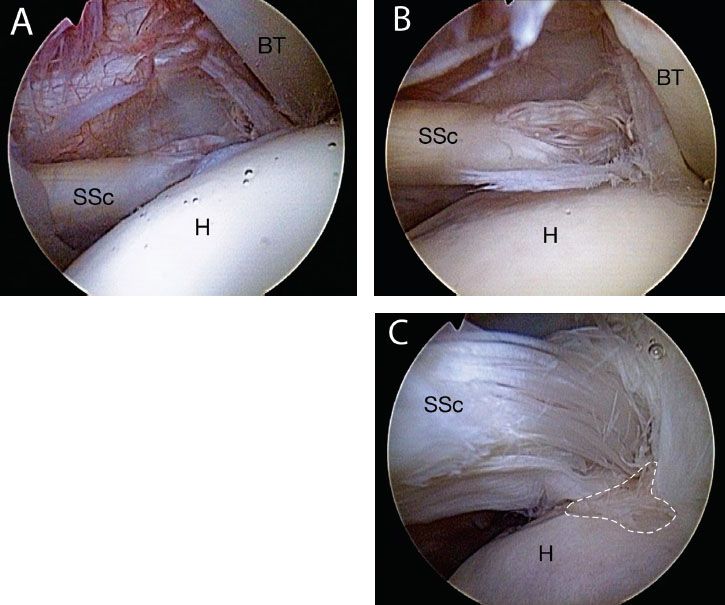
Figure 2.2 Right shoulder, posterior viewing portal comparing views obtained of the subscapularis tendon with (A) a 30° arthroscope and (B) a 70° arthroscope. With the 30° arthroscope, it is difficult to ascertain if there is a subscapularis tendon tear. The 70° arthroscope provides an “aerial view” of the footprint, and it becomes obvious that there is a tear of the upper subscapularis. C: Same shoulder viewed with 70° arthroscope and a posterior lever push. This maneuver dramatically increases the exposure of the subscapularis footprint, providing much more room for visualization, instrumentation, and bone bed preparation. In this case, an exposed subscapularis footprint (white hashed area) is quite evident at the 4 o’clock position of this picture. BT, biceps tendon; H, humeral head; SSc, subscapularis tendon.
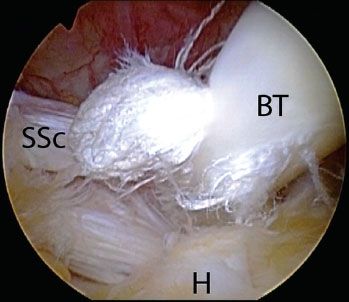
Figure 2.3 Right shoulder, viewed from a posterior portal with a 70° arthroscope, demonstrates abrasion of the medial biceps tendon. Abrasive changes of the medial biceps tendon are indicative of a subscapularis tendon tear. BT, biceps tendon; H, humerus; SSc, subscapularis tendon.
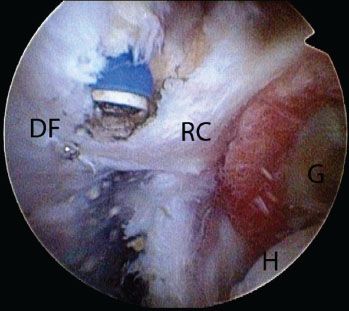
Figure 2.4 Right shoulder, viewed from a lateral subacromial portal demonstrating a bursal leader that is being separated from the deltoid fascia (DF). The bursal leader must be debrided in order to identify the intact rotator cuff (RC) margin. G, glenoid; H, humeral head.
In a broader sense, we believe in doing a complete subacromial bursectomy in all cases of arthroscopic rotator cuff repair in order to fully visualize the tear margins. Even if there are not dense bursal leaders, the subacromial bursa can obscure the cuff margins. We have heard some surgeons recommend that the bursa be preserved in order to enhance the blood supply to the cuff repair site. We disagree with this approach for three reasons. First of all, the surgeon must be sure he is repairing tendon and not just bursa, but he cannot fully visualize the tendon without first removing the overlying bursa. Secondly, the blood supply for healing that is potentially provided by the bursa is inconsequential in comparison to the blood supply from the bone bed (1). The bone bed provides growth factors and marrow elements for healing that are not available from the bursa. Thirdly, the advantage of blood supply from an intact bursa is offset by the distinct disadvantage of retaining the various degradative enzymes that are present in the bursa and which may actually retard or prevent healing if the bursa is not thoroughly debrided and excised.
Critical Biomechanical Requirements: Balancing the Force Couples and Repairing the Rotator Cable Attachments
The cornerstone of our philosophy of arthroscopic rotator cuff repair is that force couples must be restored and balanced in the coronal and axial planes (Fig. 2.5). By recognizing the tear pattern and achieving an anatomic repair, the surgeon will automatically balance the force couples unless the muscle quality is so poor that it cannot generate sufficient force to produce balanced force couples.
In general, our experience has been that if a given muscle has up to 75% fatty infiltration (as judged on the T-1 parasagittal MRI images), it will have enough elasticity to be fully repairable to its anatomic insertion (2). If there is not enough elasticity in the muscle-tendon unit for repair, and if interval slide releases fail to provide enough additional lateral excursion for repair, we simply repair as much as possible in order to achieve the best partial repair that we can. We do not believe in trying to “cover the hole” with latissimus dorsi transfers or allograft patches.
There is another critical biomechanical aspect to rotator cuff repair that is too often overlooked, and that is the importance of a secure repair of both ends of the rotator cable. In 1993, the senior author (SSB) described the cable–crescent complex of the rotator cuff (Fig. 2.6) (3). The majority of rotator cuff tears begin within the rotator crescent. As long as the rotator cable attachments are intact, the cuff muscles can produce a distributed load along the cable that gets transferred to bone at the cable attachments. In this way, a torn rotator cuff can still function by load transmission through a construct that is analogous to a suspension bridge (Fig. 2.7) (4). We have recently completed a clinical study (unpublished data) that shows that all patients who have pseudoparalysis (inability to actively elevate the shoulder above 90°) have disruption of one or both ends of the rotator cable.
The rotator cable attachments are so important to overhead function that we believe it is important to reinforce their repair during arthroscopic rotator cuff repair. The posterior cable attachment corresponds to the attachment of the lower infraspinatus. The anterior cable attachment bifurcates around the top of the bicipital groove, with part of the anterior cable attachment corresponding to the anterior attachment of the supraspinatus and the other part corresponding to the upper attachment of the subscapularis. We believe that healing of these three attachment points of the rotator cable (lower infraspinatus, anterior supraspinatus, and upper subscapularis) are crucial to optimal function of the shoulder (Fig. 2.8). Because of this crucial role, we reinforce these three points with cinch-loop sutures (infraspinatus and supraspinatus) and rip-stop sutures (subscapularis). Interestingly, a standard SutureBridge repair (two medial anchors and two lateral anchors) of a tear involving the supraspinatus and infraspinatus will frequently leave “dog ears” at the anterior and posterior margins of the repair. Placing cinch-loop sutures at the anterior and posterior margins to reinforce the repair at the anterior and posterior cable attachments will also eliminate the dog-ears (Figs. 2.9 and 2.10).
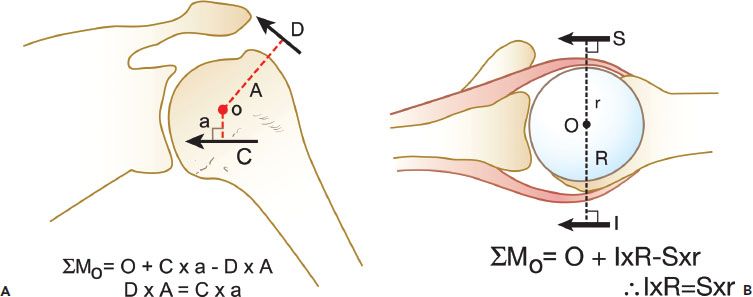
Figure 2.5 A: Balanced force couples are required to maintain the normal glenohumeral relationship. A: In the coronal plane, the combined inferior rotator cuff force (C) is balanced against the deltoid (D). B: In the axial plane, the subscapularis (S) is balanced against the infraspinatus and teres minor (I). O, center of rotation; A, moment arm of the deltoid; a, moment arm of the inferior rotator cuff; r, moment arm of the subscapularis; R, moment arm of the infraspinatus and teres minor.

Figure 2.6 Superior (A) and posterior (B) projections of the rotator cable and crescent. The rotator cable extends from the biceps to the inferior margin of infraspinatus, spanning the supraspinatus and infraspinatus insertions. C, width of rotator cable; B, mediolateral dimension of rotator crescent; S, supraspinatus; I, infraspinatus; TM, teres minor; BT, biceps tendon.
Stay updated, free articles. Join our Telegram channel

Full access? Get Clinical Tree








